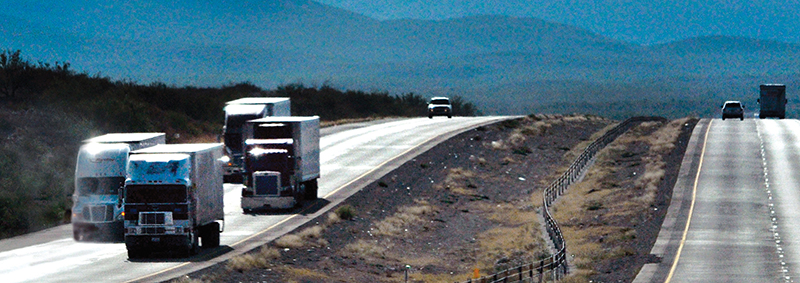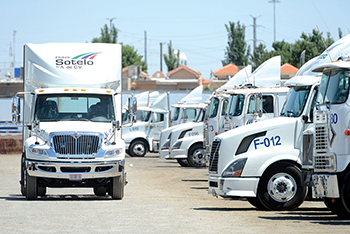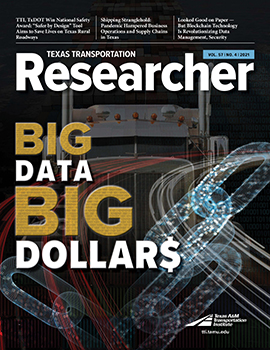Truck drivers cover hundreds of miles a day carrying goods from distribution centers to store shelves. The Federal Motor Carrier Safety Administration requires truckers to take regular breaks and stop driving altogether once they pass a certain time behind the wheel. That means they must park their trucks and rest somewhere, and that can be a challenge for state departments of transportation (DOTs) charged with keeping the supply chain moving. Knowing what parking is available and where is key to meeting this challenge. So, how can Big Data help?

The Texas A&M Transportation Institute (TTI) used INRIX data to enhance truck parking analytics to support a project for the Texas Department of Transportation and the Federal Highway Administration to develop best practices in freight planning including truck parking. The research team studied six locations: Barbours Cut (Houston, TX), Cedar Point (Houston, TX, area), Alliance (Dallas, TX), H-E-B Warehouse and Distribution (San Antonio, TX), Agribusiness Facility (Salisbury, MD) and Rural Crossroad Industrial cluster (Hagerstown, MD). The goal was to understand how traffic data can facilitate a better understanding of truck parking demand and inform decisions for DOTs. Often with limited staffing and resources, DOTs have to identify and visualize problem areas and develop site-specific opportunities. Using Big Data in easy-to-use applications frees DOT employees to spend time on the larger picture.
“At TTI, we focus on applied resources that help to simplify Big Data and tell the stories DOT staff need to communicate to decision makers and the public,” says TTI Research Scientist Nicole Katsikides. “Truck parking is a multifaceted challenge. Using Big Data as we have in Maryland and Texas, we can quickly, efficiently and accurately capture demand and identify options for solutions.”
Visualization is key for multiple audiences to fully grasp DOT staff’s stories. Converting data to a visual medium allows for a comparison of multiple data types, from parking and land-use data to safety and congestion data. Cross-comparing these different data types makes it easier to understand issues created by a lack of parking and highlights how valuable partnerships are between local governments and businesses investing in finding and implementing solutions.

TTI is currently working on a truck parking visualization tool for DOT employees to use to evaluate and monitor truck parking. For the current version of the analytics, the TTI team looked at 2019 INRIX trip data reflecting anonymized commercial vehicle trips with route details and waypoints. Using this type of Big Data, the researchers can:
- see where a truck trip originated, where the truck stops, and where it’s headed to;
- determine how fast the truck traveled and how long the trip took; and
- identify what bottlenecks occurred along the way.
TTI is also addressing special parking factors, such as border-crossing parking demand and truck parking behavior during emergencies (e.g., hurricanes).
“Big Data offers a great deal of opportunity, but at first it can be daunting because of the volume and complexity of the data itself,” notes Xiaoqiang “Jack” Kong, TTI graduate research assistant. “My colleagues and I have developed methods of using these data to help DOT staff, decision makers and stakeholders address transportation problems.”
In the context of truck parking, Kong and his colleagues take waypoints and non-moving truck trips and layer these data in with other data types to provide robust, user-friendly information. This process provides the opportunity for routine analysis of a truck parking problem. Employing this method that relies on Big Data instead of people performing manual counts can be more efficient, cost-effective and accurate — and safer.
Using INRIX data, TTI researchers built comprehensive analytics to help DOTs identify insights that can be invaluable to planning, policy and operations decision-making. Transportation agencies can use TTI’s methods to better understand where bottlenecks occur along freight corridors to, for example, redirect truck drivers to less-congested roadways, making their travel time more reliable and improving safety, not to mention boosting the bottom line. Based on this project, TTI has conducted several additional truck parking Big Data analytical projects in both Texas and Maryland, and interest in TTI’s work is now expanding into other states. In early 2022, Texas and Maryland will implement TTI’s methodology to routinely monitor truck parking and engage stakeholders in identifying much-needed solutions.

